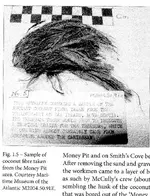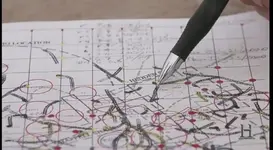Al D
Bronze Member
- Joined
- Jul 23, 2011
- Messages
- 2,066
- Reaction score
- 3,538
- Golden Thread
- 0
- Location
- Gold canyon AZ
- Detector(s) used
- DJI Air 2S
- Primary Interest:
- Cache Hunting
Naw.....it’s Templar baby.......


Show us some of the “Date verified” evidence....lolThe idea of the OI treasure being a hoax is just somebodies idea of an "easy answer" to the existence of some very perplexing and date verified evidence.
Carbon dating of wooden structures has shown that there was a sustained and heavy presence on the island long before settlers entered the area. I have been in that area and the terrain surrounding the island for a hundred miles makes travel by land very slow and arduous, the only access before the advent of roads was by water, and when approaching from the ocean you had better know where you are going with all the islands, shoals and hidden obstructions.
Considering all the heavy construction of slipways, docks and buildings predating local inhabitation this all suggests a moderate to large workforce with skilled knowledge and confident leadership. This was not an overnight affair, this would have taken some time and intelligent logistical support, just like a military operation.
If you'll notice I haven't mentioned treasure or tunnels because at this point in time there is no factual evidence to point in that direction, there are only stories and legends.
First answer the basic questions Who, Why and What were they doing, we already have a fair estimate of when. Answer those three questions and you will probably be able to conclude whether there is or is not a treasure to be found.
If the military were involved there would be physical evidence of defensive positions at key positions on the island or surrounding islands and mainland. A full archeological assessment of the surrounding area for several miles should be undertaken.
The answers will be found in the small details.
I find J.Steele's explanation the most feasible answer to what has been found.The idea of the OI treasure being a hoax is just somebodies idea of an "easy answer" to the existence of some very perplexing and date verified evidence.
Carbon dating of wooden structures has shown that there was a sustained and heavy presence on the island long before settlers entered the area. I have been in that area and the terrain surrounding the island for a hundred miles makes travel by land very slow and arduous, the only access before the advent of roads was by water, and when approaching from the ocean you had better know where you are going with all the islands, shoals and hidden obstructions.
Considering all the heavy construction of slipways, docks and buildings predating local inhabitation this all suggests a moderate to large workforce with skilled knowledge and confident leadership. This was not an overnight affair, this would have taken some time and intelligent logistical support, just like a military operation.
If you'll notice I haven't mentioned treasure or tunnels because at this point in time there is no factual evidence to point in that direction, there are only stories and legends.
First answer the basic questions Who, Why and What were they doing, we already have a fair estimate of when. Answer those three questions and you will probably be able to conclude whether there is or is not a treasure to be found.
If the military were involved there would be physical evidence of defensive positions at key positions on the island or surrounding islands and mainland. A full archeological assessment of the surrounding area for several miles should be undertaken.
The answers will be found in the small details.
What I am referring to when I stated (“Date verified” evidence) was the coconut fibers, found at different places on the island with various carbon dating results averaging circa 1750 (not quite sure of any of the dates right now.) Also samples of wood from the structures in Smiths Cove dated by Carbon 14 and dendrochronology and charcoal retrieved from the "Serpent Mound" also carbon dated.
These items were all placed in-situ by human beings and the dating of their placement is varying and approximate, the only thing that is undisputed in this whole mystery is the geographical location of the island.
The only thing that the “Date verified” evidence proves is that someone was there at that approximate time. It says nothing about who was there or what the purpose of their visit was.
There are many statements from credible sources that claim those fibers were NOT coconut.What I am referring to when I stated (“Date verified” evidence) was the coconut fibers, found at different places on the island with various carbon dating results averaging circa 1750 (not quite sure of any of the dates right now.) .
Now I just learned something about coconuts, thank you. I thought a coconut was a coconut but rushing to "fact check" your statement showed me how little I knew on the subject. Who'da thunk.
The real question is now who brought it there, it didn't just wash up with the tide, or did it?
The "Serpent Mounds" did bother me quite a bit. I've spent a fair bit of time crawling all over the mounds in Ontario and the OI one does not bear the slightest resemblance to them. I always thought it was a stretch to label it as such it could just as easily be called a "defensive fortification". Sound examination by geologists and archeologists needs to be done on so many things before jumping to conclusions and slapping labels on things.
And there-in lies the rub. Too many fanciful ideas being thrown around by untrained and semi-skilled people including myself.
Let the facts speak for themselves for there are precious few of them.
The fibers were identified by one university as eel grass, which is abundant on OI, however, eel grass did not support the pirate treasure narrative, hence it was ignored.Now I just learned something about coconuts, thank you. I thought a coconut was a coconut but rushing to "fact check" your statement showed me how little I knew on the subject. Who'da thunk.
The real question is now who brought it there, it didn't just wash up with the tide, or did it?
The "Serpent Mounds" did bother me quite a bit. I've spent a fair bit of time crawling all over the mounds in Ontario and the OI one does not bear the slightest resemblance to them. I always thought it was a stretch to label it as such it could just as easily be called a "defensive fortification". Sound examination by geologists and archeologists needs to be done on so many things before jumping to conclusions and slapping labels on things.
And there-in lies the rub. Too many fanciful ideas being thrown around by untrained and semi-skilled people including myself.
Let the facts speak for themselves for there are precious few of them.

Spoiler alert for this week's episode:
In the swamp, the producers planted the following objects for the actors to find:
a really old piece of thick glass (1600-late 1700's), probably an old pirate bottle. Later more of the stone road was excavated, and found to be curving away from the money pit. (maybe this was to give a gentler slope for the oxen to pull their heavy treasure carts up the hill). Then they find a small ancient iron lever with a square hole.
At the wash table, they find
Some plain wood
possible boot heel, likely made for a wealthier customer, carbon dated from 1492-1662 (95% confidence level). Columbus's spare boot from a stopover at the "New North Indies"?
In the money pit area, they find angled pieces of a wooden shaft 95 - 108 feet underground at a previously unknown shaft location. And a square nail from the 1700's. In borehole C8.5 at 40 feet, they find wood believed to be from the collapsed 1850 Tupper shaft. They are within 10 feet of the money pit!
The previously discovered OC1 Rosehead spike was surrounded by a material analyzed to be low calcium concrete, similar to what is expected to surround the Chappell Vault. The spike material was consistent with old iron originating from the UK.
They have been able to realize more good fortune than ever before in their quest to find out what happened on Oak Island.

As to finding more wooden shafts in the money pit area meaning they are closer to the treasure hoard is just farcical. If there was anything metal buried in the area the pattern drilling they did in season 5 would of found it. They drilled the whole area and lowered metal detectors down each drill hole. No metal was discovered so no treasure.
The logs they found in Smiths Cove were 250+ years old and were not rotting... Whos knows how much more of that structure was around for example..gassahk. Do you honestly believe that someone used trees that were cut down and have laying around on the ground for 200-300 years or more to build the tunnel braces and or stuff in smiths cove, and else where. Yes it is easier to use a tree already cut down and if only been laying around 5-20 years or so I'd agree with you on that but don't think a cut tree that is been laying there for well over 200 years is going to be much good to anyone...here is a quickie google search--
How long does a tree take to rot?
57 to 124 years
The computer model calculates that the “residence times” (how long a tree will take to completely decompose) for conifer species range from 57 to 124 years, while hardwood species are typically around on the forest floor for 46 to 71 years.
